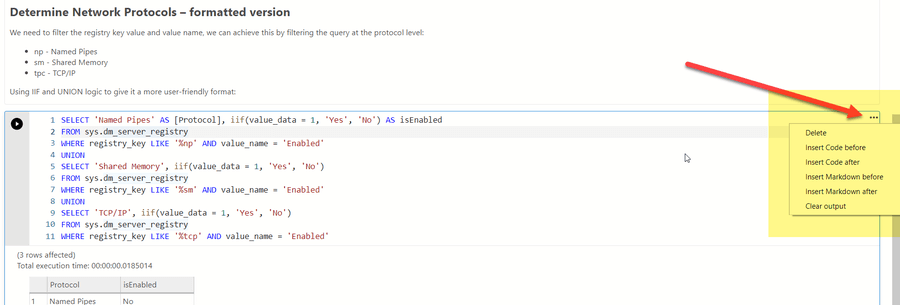
#Azure data studio notebook code
To go in reverse from a Notebook back to a T-SQL script, open your Notebook and click on the arrow in the top right corner.Įnjoy your newly found ease of collaboration in Azure Data Studio with your colleagues. Fork of VS Code Dashboards Notebooks with 6 different kernels including Python and Powershell. Notice the formatting in the Text cells with our HTML formatting. Azure Data Studio is an open source, cross-platform data management tool that works with SQL Server, Azure SQL Database and Azure SQL Data Warehouse from Windows, macOS and Linux machines. Here is our newly exported Notebook ready for us to save. To access the Command Palette in Azure Data Studio press: Windows: ctrl + shift + p. Commands do things such as modify your current code, connect to a data source, or change a setting. The Command Palette is the searchable prompt where Azure Data Studios many commands are accessed. View, inspect, and filter variables using the Variable Explorer and Data Viewer. First tip: Become familiar with the Command Palette. This topic covers the native support available for Jupyter Notebooks and demonstrates how to: Create, open, and save Jupyter Notebooks. Open the command palette ( Ctrl+Shift+P ), type 'new notebook', and select the New Notebook command. Visual Studio Code supports working with Jupyter Notebooks natively, and through Python code files.

Right-click a SQL Server connection and select New Notebook. With our T-SQL created and commented like you can see below, when you click on the Export as Notebook, we get our New Notebook broken into our text and code cells with all of our pre-setup comments. Create a notebook Go to the File Menu in Azure Data Studio and select New Notebook.

If you know a little bit of HTML you can do some work on your T-SQL and when you convert you will have some formatted comments in your text cells. We need to use block comments as this picks up and denotes the text cells and the code cells. This will make life so much easier for you and your team in collaborating and using the same scripts and processes. If you want to use the same hotkey as SSMS (Ctrl+r) or any. You can see all default key bindings by navigating to File > Preferences > Keyboard shortcuts or by using shortcut Ctrl+K Ctrl+S. Using Shift+Win+R will bring up Result and Messages pane. This new feature makes our lives easy in being able to create Notebooks from our existing T-SQL scripts. Testing confirmed Shift+Win+R will show and hide result pane. Yes you will need to have the insiders edition installed to use this feature but stay tuned for it being available in the GA version soon. Recently as part of a Hackathon a new feature “Export as Notebook” & “Export Notebook as SQL” has made it’s way into the Insiders Edition as at the time of this post. One of the best features available to assist us as Data Professions was the introduction of Notebooks and the ease of us creating and using these inside of Azure Data Studio. Azure Data Studio is a great tool for connecting with your data platform whether it is in Azure or on your hardware.


 0 kommentar(er)
0 kommentar(er)
